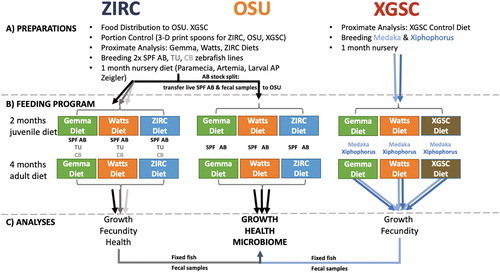- Title
-
Tenth Aquatic Models of Human Disease Conference 2022 Workshop Report: Aquatics Nutrition and Reference Diet Development
- Authors
- Sharpton, T.J., Lu, Y., Kent, M.L., Watts, S.A., Varga, Z.M.
- Source
- Full text @ Zebrafish
|
Study overview. Three diets were evaluated in parallel at three facilities (ZIRC, OSU, and XGSC), using three fish species (Medaka, Xiphophorus, and Zebrafish), and three zebrafish wild-type strains (AB, TU, and CB). (A) Preparations involved acquiring a high-fat juvenile and low-fat adult formulation of the candidate SRD from the Watts laboratory and distributing it, along with GEMMA Micro and ZIRC juvenile and adult mix, to the other sites. To ensure consistent daily rationing of food, ZIRC-designed, 3D-printed feeding spoons were sent to the other testing sites. The spoon volumes were calculated and adjusted for site-specific stocking densities and physical diet densities (g/mL). The objective was to provide each fish with an amount equivalent to 3% of its body weight in food per day, based on the average weight of 6-month-old fish (AB wild-type for ZIRC and OSU; Medaka and Xiphophorus for XGSC). Proximate, elemental, and energy content analyses were performed by Eurofins Scientific, Inc. for ZIRC for SRDs, GEMMA, and ZIRC's diet mixes. XGSC conducted additional proximate and elemental analyses for their standard liver paste and artemia-based fish diets. ZIRC bred TU and CB fish for their own tests and raised a batch of SPF AB wild types, which was evenly split between the OSU and ZIRC facilities when they reached 1 month of age. Similarly, XGSC bred Xiphophorus and medaka stocks for their studies. All fish were raised for 1 month using standard rearing protocols in the nurseries of their respective facilities. After 1 month in the nursery, the ZIRC SPF AB population was split, and 50% of the fish were transferred to OSU. (B) Feeding Program: Fish were then randomly assigned to feeding racks and tanks and fed juvenile versions of GEMMA, ZIRC Mix, and SRD diets until 3 months postfertilization. Fish then received the adult versions of the three diets for 4 additional months. Fish size (length/width) and weight measurements were conducted at 1 (ZIRC only), 4, and 7 months at each site. Fecundity and fertility tests were conducted at 4, 5, and 6 months at each site. (C) Analyses: Fish size was analyzed by photographing fish over a 1-mm grid. The pictures were loaded in FIJI (ImageJ) software to score fish length and width. Fish health was analyzed at ZIRC and OSU for their respective test groups at the end of the feeding program. In addition, Medaka and Xiphophorus health was evaluated by the Kent laboratory at OSU. Fecal samples were collected at all sites from test fish before and after feeding of adult diets. Fecal samples were shipped to the Sharpton laboratory at OSU and analyzed for gut microbiome development and composition. 3D, three-dimensional; CB, Cooch Behar; OSU, Oregon State University; SPF, specific pathogen-free; SRD, standard reference diet; TU, Tübingen; XGSC, Xiphophorus Genetic Stock Center; ZIRC, Zebrafish International Resource Center. |

